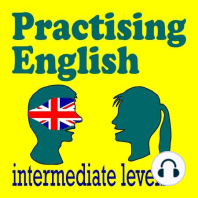11 min listen
B2 - Cycling and bicycle vocabulary
ratings:
Length:
11 minutes
Released:
Aug 11, 2021
Format:
Podcast episode
Description
Today, I'm going to talk about language around the bicycle. When you get on your bicycle, you say you push off, you push off and you start pedalling. Isn't it lovely to go out on your bicycle on a sunny day, when it's not too hot, not too cold? At the moment, I'm cycling along the river - along by the side of the river. Now, I think the first thing we could talk about is the all the different parts of the bicycle. Okay, of course it's got two wheels. And the wheels have tyres, TYRES, which are inflated. That gives you a nice, soft ride. So you ride a bicycle, you get on your bicycle, and you ride a bicycle. Sometimes if you have an accident, you can fall off your bicycle.Okay, talking about the tyres. Sometimes if you're unlucky, you can ride over something sharp and get a puncture, and the tyre deflates. And you have to get off your bike and fix your puncture. Or if you don't have a puncture repair kit, then you have to push your bicycle home. So, the wheels have spokes which are those long, thin spaghetti like things which given rigidity to the wheel. And the front wheel is held in the front forks which are two long metal parts which run down from the frame and the front wheel is inserted into the forks. Now the frame of the bicycle itself. There are different types, but often we talk about a gentleman's bike and the lady's bike and the gentleman's bike has a crossbar, which is a horizontal bar running from the top of the forks to the saddle or the seat of the bicycle, where you sit - on the saddle. And a lady's bike traditionally doesn't have that crossbar. So they don't have to, ladies don't have to lift up their leg to get over the saddle when they push off. Now, then, of course, to make the bike go along, you have to pedal and like many English words, it can be the noun, the thing or the verb. So you pedal along - you pedal, you turn the pedals and that drives a chain, which drives the back wheel. And probably you will have gears. And those gears, what they do is to allow you to go faster or slower. Go up hills. When you want to go up the hill, for example, what you'll do is to put it into a low gear, a low gear when you go downhill, or you want to go fast on the straight and you put it into a high gear. Right, the thing that you hold on to, to steer the bicycle is the handlebars. And on the handlebars, there are brakes, hopefully, the front brake and the back brake, which help to slow down the bicycle or stop it altogether. It's a good idea to check your brakes and make sure they're always working. So you don't have an accident and fall off your bike.Okay. And also on the handlebars, you've got the gear change, which is a switch or a lever, which you move to change the gears of the bicycle. So that's about it. I also usually bring along a pump, a bicycle pump to pump up the tyres if they get a little low to stop them going flat.Right, well, that's about it. Oh, one thing I forgot to mention, which is very important on your bicycle is the bell. Okay, that's all I'm going to say today on the subject of cycling. I'm going to have a nice long cycle now along the river. Enjoy myself. Test time. Right. So here are seven words that I mentioned about the bicycle. Do you remember what they were? The first one is part of a wheel, which you inflate with a pump and it gives you a softer ride. The word is tyres.Number two. This is what happens when the tyre has a hole and the air comes out of the tyre. What is it called? A puncture.Number three. This is what you need if you have a puncture. W
Released:
Aug 11, 2021
Format:
Podcast episode
Titles in the series (100)
Welcome to Practising English! by Practising English
